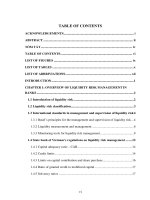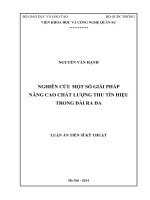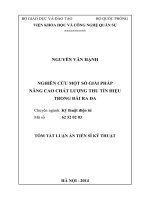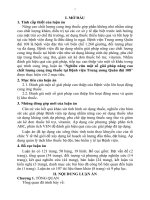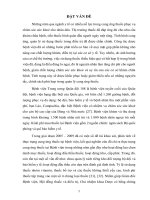Quản trị rủi ro thanh khoản trong hoạt động ngân hàng thương mại. Nghiên cứu một số giải pháp nâng cao hoạt động quản trị rủi ro thanh khoản tại Ngân hàng TMCP Kỹ thương
Bạn đang xem bản rút gọn của tài liệu. Xem và tải ngay bản đầy đủ của tài liệu tại đây (1.13 MB, 98 trang )
vi
TABLE OF CONTENTS
ACKNOWLEDGEMENTS i
ABSTRACT ii
TÓM TẮT iv
TABLE OF CONTENTS vi
LIST OF FIGURES ix
LIST OF TABLES x
LIST OF ABBRIVIATIONS xii
INTRODUCTION 1
CHAPTER 1: OVERVIEW OF LIQUIDITY RISK MANAGEMENT IN
BANKS 2
1.1 Introduction of liquidity risk 2
1.2 Liquidity risk classification 3
1.3 International standards in management and supervision of liquidity risk 4
1.3.1 Basel’s principles for the management and supervision of liquidity risk 4
1.3.2 Liquidity measurement and management 6
1.3.3 Monitoring tools for liquidity risk management 9
1.4 State bank of Vietnam’s regulations on liquidity risk management 12
1.4.1 Capital adequacy ratio – CAR 14
1.4.2 Credit limits 14
1.4.3 Limits on capital contribution and share purchase 16
1.4.4 Ratio of granted credit to mobilized capital 17
1.4.5 Solvency ratios 17
vii
1.5 Conformity of State bank of Vietnam’s regulations to the international
standards in liquidity risk management 24
1.6 Lessons from other bank’s liquidity risk management process 25
1.5.1 Overview of liquidity risk management policy 26
1.5.2 Liquidity risk policy 26
CHAPTER 2: LIQUIDITY RISK MANAGEMENT 31
AT TECHCOMBANK 31
2.1 Techcombank overview 31
2.2 Process of Liquidity risk management at Techcombank 33
2.2.1 Liquidity risk measurement at Techcombank 33
2.2.2 BOD and BOM’s risk appetite on liquidity management at Techcombank
37
2.2.3 Techcombank’s liquidity risk management structure 37
2.2.4 Techcombank’s liquidity risk management flows 41
2.3 Assessments in liquidity risk management at Techcombank 70
2.3.1 Techcombank’s compliance toward Basel and SBV’s regulations 70
2.3.2 Strengths in liquidity risk managements 72
2.3.3 Weaknesses in liquidity risk management 77
CHAPTER 3: SOLUTIONS TO IMPROVE LIQUIDITY RISK
MANAGEMENT AT TECHCOMBANK 80
3.1 Pursuing ambitious business strategy 80
3.2 Investing in information technology 82
3.3 Systemic document on liquidity risk management 83
3.4 Restructuring organization and developing HR 84
viii
3.5 Intelligent and flexible strategic in liquidity risk management 87
CONCLUSION 90
REFERENCES 91
ix
LIST OF FIGURES
Figure 2.1 Techcombank’s ALCO structure 38
Firgure 2.2 Techcombank’s Treasury structure under ALCO BSM 40
Firgure 2.3 Techcombank’s liquidity risk management process 42
x
LIST OF TABLES
Table 1.1 Credit limits on debt to clients 14
Table 1.2 Credit limits on debt to related clients 15
Table 1.3 Limits on financial leasing 16
Table 1.4 Limits on capital contribution and share purchase 16
Table 1.5: Ratio of granted credit to mobilized capital 17
Table 1.6: Overnight solvency ratio report 19
Table 1.7: 1 – 7 days solvency ratio report 21
Table 2.1: Financial highlights of Techcombank (2008 – 2011) 31
Table 2.2: 1-7 days solvency ratio for each currency 34
Table 2.3: Overnight solvency ratio for each currency 35
Table 2.4: Capital Adequacy Ratio 36
Figure 2.1 Techcombank’s ALCO structure 38
Firgure 2.2 Techcombank’s Treasury structure under ALCO BSM 40
Firgure 2.3 Techcombank’s liquidity risk management process 42
Table 2.5: Daily cash flows report 43
Table 2.6: VND Liquidity gap analysis 45
Table 2.7: USD Liquidity gap analysis 50
Table 2.8: Techcombank’s Solvency limits 55
Table 2.9: Techcombank’s Solvency ratio report at 28 and 29 March 2012 55
Table 2.10: Forecast daily solvency ratios report 57
Table 2.11: Liquidity stress testing modeling 60
xi
Table 2.12: Techcombank’s Liquidity stress testing in specific crisis 62
Table 2.13: Techcombank’s Liquidity stress testing in local market crisis 66
Table 3.1: Techcombank’s 2012 plan 81
xii
LIST OF ABBRIVIATIONS
ALCO
Assets and Liabilities Committee
ALM
Assets and Liabilities Management
ARCO
Audit and risk committee
BSM
Balance sheet management department
CAR
Capital Adequacy Ratio
CB
Corporate banking division
CEO
Chief Executive Officer
CFP
Contingency Funding Plan
FI
Financial institution division
FTP
Fund transfer pricing
LCR
Liquidity coverage ratio
MCO
Maximum Cumulative Outflows
PFS
Personal financial services
S&D
Sales and distribution division
SBV
State bank of Vietnam
SME
Small and medium enterprise
Techcombank
Viet Nam Technological and Commercial joint stock bank
1
INTRODUCTION
Risk is inherent in any business in general and in financial sector in particular. It has
become key focuses for managers and regulators since some recent decades,
specially liquidity risk, after some recent global financial crisis. After and after each
crisis, regulators want to implement stricter regulations to prevent financial
institutions from liquidity difficulties. Financial institutions’ managers also pay
much more attention to liquidity issues to ensure banks’ safe and durable
development.
The subject of thesis focuses on liquidity risk management. This is nearly new and
hot topic in Vietnam financial market, since State bank of Vietnam has just issued
regulations on prudential ratios in 2010 and series of its amendment right after. The
regulations affect immediately banks’ balance sheet structure and also long term
business orientation.
It’s necessary to study on the subject to understand the international principles,
measurement and management practices to apply adequately in Vietnam
environment. Thesis aims how to respond to local regulations of SBV and step by
step implement international acceptable practices.
Thesis studies case of Techcombank, one of most successful joint stock in Vietnam
banking sector in the last decade. Techcombank also is good example to make
analysis because the bank has applied not only local regulations but also starting
itself to set up internal requirements to reach international practices.
2
CHAPTER 1: OVERVIEW OF LIQUIDITY RISK
MANAGEMENT IN BANKS
1.1 Introduction of liquidity risk
Risk occurs in any business in general and in banking sector in particular. It can be
said that banks run business in the most “sensitive” environment with special
product of money. Risks are any events that may negative impact on the bank
business. It can be classified in four types of risk in banking sector. They are credit
risk, market risk, operations risk, and liquidity.
We almost know about the first three risks. Credit risk is the risk that borrower fails
to repay a loan or other contractual obligation at right time and right amount, while
market risk occurs day to day according change in price of financial assets. And
finally, operation risk arises from execution of business functions, is the risk of loss
resulting from inadequate or failed internal processes, people and systems or from
external events.
They all three risks come directly from business. But the last one is different, it is
consequential risk. It arises from underlying problems. They can be endogenous or
exogenous. Endogenous problems are most often credit risk and, some times
operation risk. Exogenous problems are also result from market disruptions,
sovereign downgrade and any other events that could impact bank’s business.
Liquidity is the ability of a bank to fund increases in assets and meet obligations as
they come due, without incurring unacceptable losses. This definition is broader
than that concept that is only possession of cash or assets that can be readily
converted into cash.
Liquidity risk management nowadays has become one of most challenging to any
financial managers. Understanding the term, risk classification and measurement
3
that help managers well control the risk and lead business to achieve their targets
and goals.
1.2 Liquidity risk classification
Liquidity risk could arise from internal or external factors. And level of liquidity
risk, as well as the quantity of the available sources of liquidity, varies, depending
on circumstances and their duration. In other words, specific circumstances define
level of liquidity risk. By understanding each specific circumstance, managers could
sound understanding, measuring, and managing of liquidity risk.
According to best practice in the financial market, liquidity risk is classified into
three categories, including:
- Structural liquidity risk
- Contingency liquidity risk
- Market liquidity risk
Structural liquidity risk refers to the liquidity risk in the bank’s current balance
sheet structure due to maturity transformation in the cash flows of each individual
position. This also called mismatch risk that results from both contractually and
behavior driven cash flows.
Contingency liquidity risk is the risk that future events may require a significantly
larger amount of cash than a bank projects it will need. It is the risk of not having
sufficient funds to meet sudden and unexpected short term obligations. Unexpected
obligations can arise due to unusual deviations in the timing of cash flows or
unexpected deposit withdrawals.
Market liquidity risk refers to the inability to sell assets at or near the fair value.
Market liquidity risk may arise when a market disruption impairs the bank’s ability
to sell large positions or lower quality positions. Market liquidity may also result
from impaired access to the respective markets, for examples, after loss of
reputation.
4
Aggressive expansion and fast development of financial services increased
competition for liabilities side. These lead capital market changes that impact both
the level of liquidity risk and the available tactics for managing risk. Understanding
liquidity risk sources and its trends are very important to prevailing adequate
measurement and managing activities.
1.3 International standards in management and supervision of liquidity risk
1.3.1 Basel’s principles for the management and supervision of liquidity risk
After the market turmoil that began in mid 2007, liquidity has become key focus of
all managers in financial markets and the banking sector. Basel Committee on
banking supervision of BIS started to study deeply on liquidity issue, review issues
already done in the year of 2000, and in February 2008, it published Liquidity Risk
Management and Supervisory Challenges. After more than a half year, principles
for sound liquidity risk management and supervision was issued to guideline bank
managers to implement liquidity risk management.
This guidance of Basel Committee highlights seventeen principles for managing
and supervising liquidity risk:
1.3.1.1 Fundamental principles for the management and supervision of
liquidity risk
Principle 1: A bank should establish a robust liquidity risk management framework
that ensures it maintains sufficient liquidity to deal with stress events. It includes
maintaining quality liquidity assets, their marketability and assessing depositors,
access to secured and unsecured funding sources.
1.3.1.2 Governance of liquidity risk management
Principle 2: Bank should establish risk appetite for its own business, including
liquidity risk tolerance.
5
Principle 3: Bank should develop a strategy, policy and practices for managing
liquidity risk according to bank’s risk appetite. These should be reviewed regularly
at least annually.
Principle 4: Bank should develop an internal fund pricing system that includes
liquidity costs, benefits and risks that products and services create for bank’s
portfolio.
1.3.1.3 Measurement and management of liquidity risk
Principle 5: Bank should establish a sound process for indentifying, measuring,
monitoring and controlling liquidity risk.
Principle 6: Bank should actively monitor and control liquidity risk.
Principle 7: Bank should develop an effective and diversified funding strategy.
Principle 8: Bank should actively manage intraday liquidity position to meet all
payments on timely basis under normal and stress conditions.
Principle 9: Bank should actively manage collateral positions.
Principle 10: Bank should conduct stress tests regularly for short term and bank case
specific and market case specific. After conducting stress test, bank could review
and adjust liquidity risk strategy and policy do develop effective contingency plan.
Principle 11: Bank should have official contingency funding plan that defines
strategies for liquidity shortfalls in emergency case.
Principle 12: Bank should maintain a cushion of unencumbered assets, high quality
liquid assets to withstand a range of stressed scenarios.
1.3.1.4 Public disclosure
Principle 13: Bank should publicly and regularly disclose information so that
market participants could know about the change in liquidity risk management
framework and liquidity position.
1.3.1.5 The roles of supervisors
6
Principle 14: Supervisors should regularly make comprehensive assessment of
overall liquidity position and framework.
Principle 15: Supervisors should supplement assessments of liquidity risk
management framework by monitoring a combination of internal reports, prudential
reports and market information.
Principle 16: Supervisors should intervene to require effective and timely remedial
actions to ensure bank’s liquidity.
Principle 17: Supervisors should communicate with regulators and other
stakeholders to keep update and effectively cooperate regarding to supervision and
overview of liquidity risk management.
These principles guide not only bank managers to build up and conduct effectively
liquidity risk management framework, but also regulators to implement adequately
to each country.
The fundamental principles create general framework on liquidity risk management
that work through all concepts and documents related to the issue. After studying on
risk liquidity risk from term to classification and management principles, we should
move on how to measure and manage liquidity risk.
1.3.2 Liquidity measurement and management
Liquidity risk management is essential for the long term viability of a bank. It can
be said that it is the most challenging financial risk; not because managers do not
understand well the risk, but because managers often take different approaches and
the “flexible” adjustments depending on specific case of bank.
But almost managers should agree in some common concepts and standards on
measuring and managing liquidity risk.
Basel Committee on banking supervision issued Basel III that guided two common
standards to use in liquidity risk management. They are Liquidity Coverage Ratio
and Net Stable Funding Ratio.
7
1.3.2.1 Liquidity Coverage Ratio (LCR)
100
dayscalendar 30next over the outflowscash net Total
assets liquidquality -high ofStock
LCR means minimum level of stock of high quality liquid assets that can be
converted into cash to ensure bank’s liquidity during 30 calendar day time horizon.
LCR is expected to meet requirement for each common currency so that bank is
ready to liquidity of each currency in daily operation.
Stock of high quality liquid assets
This numerator requires bank maintain adequate limit of encumbered liquid assets
to meet its liquidity.
These assets could be easily and immediately converted to cash at little or no loss of
value. This depends on specific stress scenarios, amount and also time frame. It’s
ideal if these assets are eligible at central bank for intraday liquidity and overnight
operation.
These assets involve characteristics as follows:
- Low credit risk and market risk
- Ease and certainty of valuation
- Low correlation with risky assets
- Listed on developed and recognized exchange market
- Active and sizable market
- Presence of committed market makers
- Low market of concentration
- Flight to quality
8
Bank should manage pool of these assets quite clear and separately with trading
purpose. The assets must be unencumbered to secure for any other transactions. So
that they are readily to immediately convert to cash to meet liquidity if any.
Bank should also test regularly market condition to know exactly liquidity
characteristic of assets.
Basel III suggests classify these assets into level 1 and level 2 assets. Level 1 assets
include assets held at market value and not subject to haircut under LCR, such as:
cash, central bank reserves, marketable securities guaranteed by sovereign, central
bank, IMF,…Level 2 assets comprise no more than 40% of overall stock after
haircuts such as corporate bonds and other securities that satisfy specific conditions
of Basel.
Total net cash outflows
Total net cash outflows equals total expected cash outflows minus expected cash
inflows in specific scenarios for 30 calendar days.
outflows of 75% Inflows; Min - Outflows outflowscash net Total
Total expected cash outflows are calculated by multiplying all balances of payables,
liabilities or off balance sheet commitments to the rate that expected to run off.
Total expected cash inflows are calculated by multiplying all balances of
receivables to the rate that expected to flow in with the cap of 75% total expected
outflows.
To manage cash outflows, bank should pay attention to products:
- Retail deposit run off
- Unsecured wholesale funding run off
- Secured wholesale funding run off
- And other additional requirements such as: derivative payables, loss of asset
backed securities, downgrade triggers,
9
1.3.2.2 Net Stable Funding Ratio - NSFR
100
funding stable ofamount Required
funding stable ofamount Available
NSFR is structured to ensure that long term assets are funded at least a minimum
amount of stable liabilities in relation to their liquidity risk profile.
Available amount of stable funding is total sum of:
- Capital
- Preferred stock with maturity that equal or greater than one year
- Liabilities with maturity that equal or greater than one year
- Portion of non maturity deposits or term deposits under one year but
expected to remain with financial institutions when it due or under stress
scenarios.
- Portion of wholesales under one year but expected to remain with financial
institutions when it due or under stress scenarios.
Required amount of stable funding for assets and off balance sheet exposure is
measured by using supervisor assumptions on the broad characteristics of liquidity
profile of assets, off balance sheet exposures and other activities. It is calculated as
the sum of assets held and funded, multiplied by a specific required stable funding
(RSF). Basel III also guides detailed compositions of asset categories and associated
RSF so that financial institutions could easily apply.
1.3.3 Monitoring tools for liquidity risk management
Besides these two standards in the section above, Basel III has guided series of
monitoring tools as a framework for liquidity risk management. But supervisors
may need add supplement and develop this framework by using additional tools to
capture liquidity risk adequate to their bank’s business environment.
These tools include the five following:
10
- Contractual maturity mismatch
- Concentration of funding
- Available unencumbered assets
- LCR by significant currency
- Market related monitoring tools
1.3.3.1 Contractual maturity mismatch
Contractual maturity mismatch defines gaps between contractual inflows and
outflows for each time bucket. This gap analysis helps managers know how much
fund they need to raise up or surplus for each time bucket.
The gaps are calculated by netting all inflows and outflows from all on balance
sheet and off balance sheet items, mapped respectively to their maturities.
Time bucket can be constructed for overnight, 7 days, 14 days, 1, 2, 3, 6 and 9
months, 1, 2, 3, 5 and beyond 5 years. And the data collected for the gap report
should at least at detailed categories as liquidity coverage ratio.
Based on contractual gap, banks should make necessary assumptions to reflect
specific bank case to forecast reasonable in and out cash flows so that the gaps
produce report more useful information for managers.
1.3.3.2 Concentration of funding
This metric aims to define sources of wholesale funding that could impact
significant to institution when they are withdrawn.
Some of the practical applications in manage concentration of funding:
sheet balance totalsbank' The
ty counterpart significaneach from sourced sliabilitie Funding
sheet balance totalsbank' The
strument product/int significaneach from sourced sliabilitie Funding
11
List of asset and liability amounts by significant currency
These applications measure concentration of funding, to know how bank depends
on each significant counterparty or product/instrument. One counterparty or
product/instrument are considered as significant if aggregate amount of that
counterparty or product/instrument count for more than 1% of total bank’s balance
sheet.
In order to capture the amount of structural currency mismatch, bank must provide a
list of the amount of assets and liabilities in each significant currency. To be
consider as significant currency, aggregate liabilities in that currency must be
counted for or more 5% of total liabilities.
1.3.3.3 Available unencumbered assets
Available unencumbered assets are marketable as collateral in secondary market
and/or eligible for central banks’ standing facilities.
These assets are additional sources of bank’s liquidity. Supervisors must know
quantity and key characteristics of the assets for bank’s liquidity in emergency case,
including secondary market condition (haircuts, aggregate amount, counterparty…)
and central bank’s related policies for each period.
1.3.3.4 Liquidity coverage ratio by significant currency
In order to better capture currency mismatch, bank should also monitor liquidity
coverage ratio for each significant currency.
currencyt significaneach in period day time 30 aover outflowscash net Total
currencyt significaneach in asets liquidquality high ofStock
LCRCurrency Foreign
As the foreign currency LCR is a monitoring tool, not a standard, so it does not
have an international minimum requirement, bank supervisors and managers should
establish minimum level to monitor adequately to bank’s specific case and
environment.
12
1.3.3.5 Market related monitoring tools
High frequency market data with little or no time lag can be used as early warning
indicators in monitoring potential liquidity difficulties.
Supervisors could monitor following information to focus on liquidity issues:
- Market wide information
- Information on financial sector
- Bank – specific information
Basel III has guided principles, measurement standards and monitoring tools for
liquidity risk management. These have become international guidelines that
implements more and more widely in over the world. Each central bank studies and
implements, adjusts if needed these guidelines into specific conditions of country.
1.4 State bank of Vietnam’s regulations on liquidity risk management
Regulators always want to set up common standards to control the risks, stabilize
macro environment, and ensure safe business, specially, in banking sector.
By understanding the international standards in liquidity management, applying in
the Vietnam position, state bank of Vietnam also issued the regulations on
prudential ratios in operations of credit institutions; including the liquidity ratios.
The regulations are detailed in the following documents:
- Circular number of 13/2010/TT-NHNN dated May 20, 2010 of the State
Bank of Vietnam stipulating prudential ratios in operations of credit
institutions;
- Circular number of 19/2010/TT-NHNN of September 27, 2010, on
amendment, supplement of several articles of the Circular No. 13/2010/TT-
NHNN dated 20 May 2010 of the Governor of the State Bank providing for
the prudential ratios in activities of credit institutions;
13
- Circular number of 22/2011/TT-NHNN of August 30, 2011, on the
amendment, supplement of several articles of the Circular No. 13/2010/TT-
NHNN dated 20 May 2010 of the Governor of the State Bank on prudential
ratios in activities of credit institutions;
- Circular number of 33/2011/TT-NHNN of October 08, 2011, of the State
Bank of Vietnam amending, supplementing some articles of the Circular No.
13/2010/TT-NHNN dated May 20, 2010 of the State Bank of Vietnam
stipulating prudential ratios in operations of credit institutions and
regulations on lending by credit institutions to clients issued with the
Decision 1627/2001/QD-NHNN dated December 31, 2001 of the governor
of the state bank.
It is also called Circular number of 13, in brief. These regulations refer to credit
institutions operating in Vietnam, excluding the Social Policy Bank, the Vietnam
Development Bank and grassroots people's credit funds. Prudential ratios stipulated
in this Circular include:
- Capital adequacy ratio;
- Credit limits;
- Limits on capital contribution and share purchase;
- Ratio of granted credit to mobilized capital;
- Solvency ratio;
These five ratios attempt to manage bank’s operations in line of risk limit, to ensure
the reasonable risk tolerance in each credit institution. By complying with these
regulations, each bank meets the common standards to reduce the risks in the
business, including liquidity risk.
We pass shortly the first four ratios and focus on the last one relating to liquidity
management.
14
1.4.1 Capital adequacy ratio – CAR
Individual capital adequacy ratio =
Own capital
Total risk-weighted assets
Banks must maintain CAR of 9% as individual and also consolidated capital
adequacy ratio on the basis of consolidation of capital and assets of their own and
their affiliated companies.
1.4.2 Credit limits
In this term, SBV sets up the limits on loans, guarantees and discounts of valuable
papers to financial institution.
Some limits on debt to clients as following:
Table 1.1 Credit limits on debt to clients
No
Ratios
Limit
1
Debt/Capital for single client
15%
2
Debts and guarantee amounts/Capital for single client
25%
3
Debts/Capital for a group of related clients
50%
4
Debts and outstanding guarantee amounts/Capital for a
group of related clients
60%
A credit institution may not grant unsecured credits and credits under preferential
conditions to enterprises which the credit institution holds the right to control, and
shall comply with SBV’s restrictions:
15
Table 1.2 Credit limits on debt to related clients
No
Ratios
Limit
1
Debts and guarantee amounts/Capital for an enterprise that
credit institution has right to control
10%
2
Debts and guarantee amounts/Capital for more than one
enterprise that credit institution has right to control
20%
3
Unsecured credit/Capital to financial institution's affiliated
financial leasing companies
5%
4
Credit to its affiliated companies being securities trading
businesses
0%
A credit institution may not provide unsecured loans for securities investment and
trading.
The total outstanding debts and discounts of valuable papers for all clients for
securities investment and trading must not exceed 20% of the credit institution.
In case the capital need of a single client exceeds the loan limits specified in the
clauses above, credit institutions and foreign bank branches may provide
syndicated credit under regulations of the State Bank.
In special cases, in order to perform socio economic tasks, if capital syndication
abilities of credit institutions and foreign bank branches fail to meet loan or
financial lease requirements of a single client, the Prime Minister may decide on
specific loan or financial lease levels on a case-by-case basis.
Limits on financial leasing
16
Table 1.3 Limits on financial leasing
No
Ratios
Limit
1
Total financial leasing debts/Own capital of financial
leasing company for single client
30%
2
Total financial leasing debts/Own capital of financial
leasing company for a group of related clients
50%
1.4.3 Limits on capital contribution and share purchase
Table 1.4 Limits on capital contribution and share purchase
No
Ratios
Limit
1
Capital contribution and share purchase to an enterprise, an
investment fund, an investment project or another credit
institution/ Charter capital of the latter
(except founding affiliated company under law)
11%
2
Capital contribution and share purchase of a credit
institution and its subsidiaries, joint-venture companies and
associated companies in a single enterprise, investment
fund, investment project or another credit
institution/Charter capital of the latter.
11%
3
Capital contribution and share purchase in all of its
affiliated companies/Charter capital and reserve fund
25%
4
Capital contribution and share purchase in all enterprises,
investment funds, investment projects or other credit
institutions and in its affiliated companies/ Charter capital
and reserve fund
40%
17
1.4.4 Ratio of granted credit to mobilized capital
Credit institutions must comply with all regulations on solvency ratio and other
prudential ratios stipulated in the circular before and after of grant of credits.
Table 1.5: Ratio of granted credit to mobilized capital
No
Ratios
Limit
(maximum)
1
Mobilized capital/ Granting credit for bank
80%
2
Mobilized capital/ Granting credit for non bank credit
institutions
85%
Grant of credit includes lending, financial leasing factoring, guarantee and discount
of valuable papers and negotiable instruments.
Mobilized capital includes:
- Demand deposits and time deposits of individuals;
- Time deposits of organizations (excluding State Treasuries), including also
those of other credit institutions and foreign bank branches:
- Loans provided by domestic organizations (excluding State Treasuries and
loans provided by other domestic credit institutions) and loans provided by
foreign credit institutions:
- Capital mobilized from organizations and individuals through issuing
valuable papers.
1.4.5 Solvency ratios
Solvency ratios (also called liquidity ratios) are important part in the Circular, it
requires credit institutions maintain hardly solvency ratios including overnight
18
solvency ratio and 1-7 days solvency ratio in daily basis and currency basis (VND,
USD, EUR, JBP).
The regulations impact strongly the bank operations and strategic assets allocation.
It must establish the responsible unit to manage daily liquidity, and to cooperate
the relating units in the bank to ensure the ratios in limits. The unit is in charge of
issuing, amending and updating internal liquidity management policy to comply
with the limits.
The Circular also requires the minimum contents to guide each credit institution to
set up liquidity management policy:
- Responsibilities and rights of related units in managing solvency ratios
- IT system to support generating daily reports
- Solutions to temporary liquidity difficulties
- Adequacy allocation into high liquidity assets
- Applying adequacy models for liquidity stress test and scenario test
Solvency ratios
There are two solvency ratios: overnight and 1-7days solvency ratio
Overnight solvency ratio: minimum at 15%


